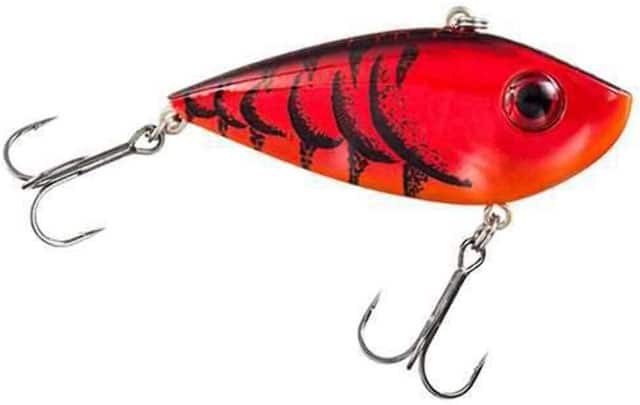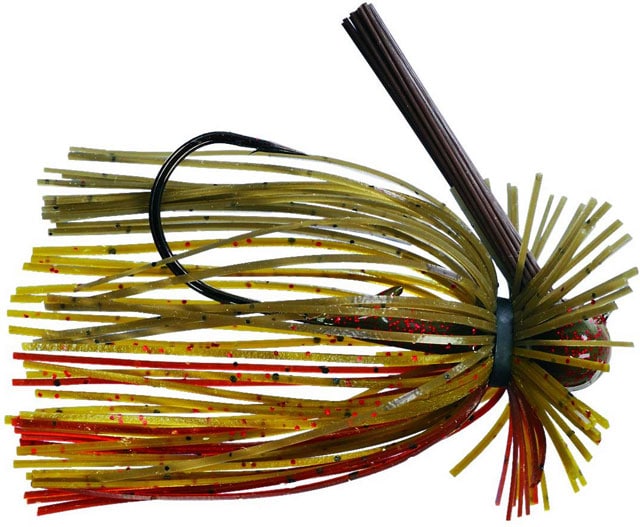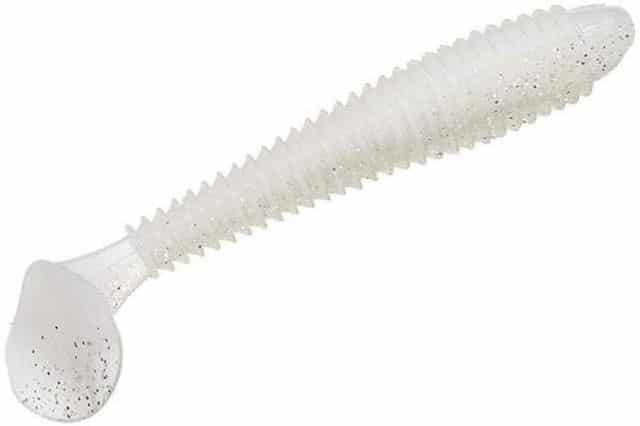During the winter season, bass fishing can be slow. It’s often difficult to provoke fish to bite on those cold, windy winter days. However, despite the fact that bass can be finicky this time of year, it is possible to catch them.
You simply must employ the right lures and present them in a way that is enticing enough for fish to go after them.

Rapala Shadow Rap 11 (Jerkbait)
As the water gets cold, a bass’ metabolism decreases, and the fish get lethargic and slow moving. They won’t swim very far for a meal, and the less likely they are to chase down a bait.
A few tactics to get sluggish fish to bite include slowing your retrieve, downsizing your lures, and making multiple casts into the same area to get bass to strike. When it comes to the best wintertime bass lures, there are a handful that shine.
My top lure choices during the winter months include:
- Suspending jerkbait
- Crankbait
- Jig
- Soft-plastic swimbait or fluke
- Shaky head worm
Each of these baits can be fished slowly and kept in the strike zone for long periods of time, giving slothful bass time to react.
Top 10 Best Coldwater Bass Lures
I’m going to go through the best types of coldwater bass lures in a ton of detail below, including sizes, colors, everything. But I wanted to give you a quick glance at my favorites first.
| Rank | Picture | Name (Color) | Type | Where to Buy |
|---|---|---|---|---|
| 1 |  | Rapala Shadow Rap 11 (Elite Pro Blue) | Jerkbait | See it on Amazon |
| 2 |  | Rapala Ripstop (Albino Shiner) | Jerkbait | See it on Amazon |
| 3 |  | Strike King KVD Jerkbait (Pro Bone) | Jerkbait | See it on Amazon |
| 4 |  | Strike King Red Eye Shad (Chili Craw) | Crankbait | See it on Amazon |
| 5 |  | Booyah Hard Knocker Lipless Crankbait | Crankbait | See it on Amazon |
| 7 |  | Strike King Tour Grade Football Finesse Jig Bait (Green Pumpkin Craw) | Jig | See it on Amazon |
| 6 |  | Strike King Tour Grade Football Jig (Black Blue) | Jig | See it on Amazon |
| 8 |  | Strike King Rage Swimmer (Pearl) | Swimbait | See it on Amazon |
| 9 |  | Strike King Tail Craw (Black Blue Flake) | Swimbait | See it on Amazon |
| 10 |  | ZOOM Trick Worm (Green Pumpkin Red) | Shaky head worm | See it on Amazon |
1. Suspending jerkbait
A hard, suspending jerkbait is my number one choice during the winter and is an excellent lure for targeting sluggish bass.
Jerkbait fishing is a very visual technique, so these lures tend to excel in clear bodies of water rather than stained fisheries.

Rapala Shadow Rap 11 (Elite Pro Blue)
Alternatives I love are:
- Rapala Shadow Rap 11 (Colors: Ghost, Bone, Moss Black Shiner)
- Rapala Ripstop (Colors: Albino Shiner, Elite Blue)
- Strike King KVD Jerkbait (Colors: Pro Bone, Chrome Blue, Chartreuse Shad)
Each of these lures has exceptional darting action, making it hard for fish to resist. Each of these jerkbaits are offered in both shallow diving and deep diving versions. If I want to cover water in the 3-6 foot range, I’ll throw a shallow diving bait. And if fishing deeper than 6 feet, a deeper diver is necessary.
I usually stick with a larger jerkbait, with three hooks, unless the bite is slow. Then I’ll downsize my lure to the smallest version of the Ripstop, which is shorter and has only two hooks. When bass aren’t reacting to a larger bait, tying on a smaller one can be a difference maker and trigger those same fish to strike.
Jerkbaits can be productive all year long, but especially during the winter. They work best when fished around shoreline or open water structure, such as riprap (rocks), bridges, and seawalls. In addition, jerkbaits can produce large numbers of fish if schooling bass are present.
3 specific tips when using a jerkbait in cold water
- Giving your rod a jerk, jerk, pause action. This allows a jerkbait to have tremendous erratic action and movement in the water. The lure appears to bass as an injured baitfish and presents an easy meal.
- The colder the water, the longer anglers should pause the bait and let it suspend in the water column. This gives lazy, yet curious bass time to approach the lure and see if it’s worth attacking.
- Begin with a 3-5 second pause. This allows the fish to tell me how fast they want it retrieved. When the water is really cold or bite is super slow, I will pause a jerkbait as long as 10 seconds.
2. Crankbait
A crankbait is another good choice to throw in cold water. The best types of crankbaits for wintertime include both lipless and flat-side crankbaits.
There are lots of struggling shad in most fisheries this time of year and lipless crankbaits imitate those baitfish very well. Use what’s known as the yo-yo style retrieve to hop these lures off the bottom.

Strike King Red Eye Shad (Chili Craw)
Another great lipless crankbait:
- Strike King Red Eye Shad (Color: Delta Red, Bad to the Bone)
- Booyah Hard Knocker Lipless Crankbait (Color: Bling)
A ½ ounce craw, chartreuse, or shad colored bait is my go-to when throwing a lipless crankbait in cold water.
What about flat-side crankbaits?
A flat-side crankbait is another great imitator of cold water shad, because they have a tight wobble and slower swimming action.
The best flat-side crankbaits for coldwater are:
- Strike King KVD Flat Side (Colors: Blue Gizzard)
- Rapala Shad Rap 07 (Colors: Silver, Shad)
These lures come in a wide range of sizes and colors; I use the same colors patterns that I do with lipless crankbaits.
3 flat-side crankbait tips
- Vary the size of your lure based on the size of the forage in a certain body of water.
- The smaller the baitfish, the smaller your lure.
- Flat-side crankbaits excel when fished along the bottom near riprap (rocks), fallen trees, ledges, creeks, and channels.
3. Jig
A jig is another productive wintertime lure. There are a wide variety of jigs for an angler to choose from, but I prefer using either a football jig, a finesse jig or a swim jig during the cold months.

Strike King Tour Grade Football Finesse Jig Bait (Green Pumpkin Craw)
Other colors and styles of the Strike King you can use:
- Strike King Tour Grade Football Finesse Jig Bait (Colors: Black Blue)
- Strike King Tour Grade Football Jig (Colors: Black Blue, Gator Craw)
How to use a football jig for bass in coldwater
Typically, I’ll throw a 3/8 to ½ ounce bait, paired with a Strike King Rage Tail Craw as a trailer. This imitates crawfish extremely well. Try to stay away from thick vegetation when using a football jig and focus on fishing hard bottom, like sand or shell. I always try to keep my jig in contact with the bottom and crawl it over structure during the winter.
If I’m looking to throw a smaller lure, I like a ¼ ounce Strike King Bitsy Bug Jig. I turn to a mini jig when the bite is slow and fish won’t respond to a larger profile lure.
I’ll turn to a swim jig if I’m fishing more grass because it comes through the vegetation better that a football jig. I like pairing a swim jig with a Strike King Rage Swimmer as a trailer.
When it comes to color selection, I prefer a more natural green pumpkin colored bait in clear water, while a darker black and blue bait is my go-to in stained or murky water.
Work the jig slow
No matter what type of structure you are targeting, working a jig slowly during the winter is usually key to getting bites. Anglers can drag them slowly along the bottom, skip them under boat docks, pitch them into thick cover, swim them through grass, or crawl them over rocks and laydown trees.
4. Soft-plastic swimbaits and flukes
Soft-plastic swimbaits and flukes are also great baitfish imitators and a reliable option when the water is cold.

Strike King Rage Swimmer (Pearl)
For alternatives, switch up the size and color, such as:
- Strike King Rage Swimmer (Colors: Green Pumpkin, Electric Shad, Ghost Shad)
- Strike King Tail Craw (Colors: Black Blue Flake, Green Pumpkin)
- Zoom Super Fluke Bait (Colors: Pro Blue Red Pearl, Watermelon Seed)
How to use soft-plastic swimbaits
I rig the bait on a ¼ to ½ ounce jig head, depending on what depth I’m fishing, and swim it slowly around shoreline cover. If I want to slow my presentation even more, I turn to a Zoom Super Fluke in White Pearl color.
I rig this bait on a 4/0 VMC Wide Gap hook without a weight and let it slowly flutter to the bottom, giving it the look of a dying baitfish. If I want to fish a fluke deeper, I will occasionally rig it on a Gamakatsu Weighted EWG Widegap hook, which allows the bait to fall faster.
Both of these techniques are likely to produce lethargic fish during the winter when fished around cover, such as boat docks, grass, and laydown trees.
5. Shaky head worm
The final bait in my wintertime arsenal is a shaky head worm. A shaky head rig is typically a floating, straight-tail worm.

ZOOM Trick Worm (Green Pumpkin Red)
- ZOOM Trick Worm (Colors: Junebug Red)
- Strike King Tour Grade Shaky Head Jig (Colors: Green Pumpkin)
How to use a shaky head worm in coldwater
The worm is meant to move gently in the water as the jig head rests on the bottom.
Anglers need not move the bait very far or fast, as the lure is most effective when barely moved along the bottom. Lightly shaking the tip of your rod will allow the worm to shimmy and shake on the bottom, a movement that is often too much for lethargic bass to pass up. Slow moving bass see this as an easy meal that they don’t have to chase down.
A shaky head rig shines when skipped under boat docks and fished around brush piles or other submerged cover.
Over to you
Be sure to give some of these techniques a try the next time you head out on the water to brave the cold. Although bass fishing this time of year can be a grind, if you employ the proper baits and slow your presentation, you will increase your chances of being successful this winter.
I hope these tips helped to simplify what lures to have in your winter tackle box. Be sure to check out our YouTube for plenty more helpful tips headed your way soon! Happy fishing and keep you hooks wet!
Below are a few photos of some of the bass I’ve caught last winter utilizing these cold-water techniques.
